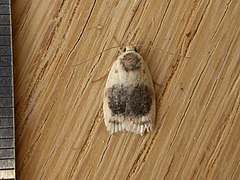| Garrha ocellifera | |
|---|---|
 | |
| Scientific classification | |
| Kingdom: | |
| Phylum: | |
| Class: | |
| Order: | |
| Family: | |
| Genus: | |
| Species: | G. ocellifera |
| Binomial name | |
| Garrha ocellifera (Meyrick, 1883) | |
| Synonyms | |
| |
Garrha ocellifera is a moth of the family Oecophoridae. It is found in Australia, where it has been recorded from Queensland, New South Wales, the Australian Capital Territory, Victoria and Tasmania.

Moths comprise a group of insects related to butterflies, belonging to the order Lepidoptera. Most lepidopterans are moths, and there are thought to be approximately 160,000 species of moth, many of which have yet to be described. Most species of moth are nocturnal, but there are also crepuscular and diurnal species.

Oecophoridae is a family of small moths in the superfamily Gelechioidea. The phylogeny and systematics of gelechoid moths are still not fully resolved, and the circumscription of the Oecophoridae is strongly affected by this.

Australia, officially the Commonwealth of Australia, is a sovereign country comprising the mainland of the Australian continent, the island of Tasmania, and numerous smaller islands. It is the largest country in Oceania and the world's sixth-largest country by total area. The neighbouring countries are Papua New Guinea, Indonesia, and East Timor to the north; the Solomon Islands and Vanuatu to the north-east; and New Zealand to the south-east. The population of 25 million is highly urbanised and heavily concentrated on the eastern seaboard. Australia's capital is Canberra, and its largest city is Sydney. The country's other major metropolitan areas are Melbourne, Brisbane, Perth, and Adelaide.
The wingspan is about 14.5–17 mm. The forewings are pale ochreous, with a small cloudy dark purplish-fuscous semi-oval spot on the inner margin near the base and a large roundish well-defined dark purplish-fuscous blotch in the middle of the disc. Within this blotch are two rather large roundish spots of whitish blue scales mixed with blackish, each surrounded by a suffused blackish ring. Between the blotch and the apex is an outwardly-curved cloudy dark fuscous transverse line and there are two or three dark fuscous-grey scales on the hindmargin around the apex. The hindwings are dark fuscous-grey, but whitish-ochreous towards the base and costa. [1]

The wingspan of a bird or an airplane is the distance from one wingtip to the other wingtip. For example, the Boeing 777-200 has a wingspan of 60.93 metres, and a wandering albatross caught in 1965 had a wingspan of 3.63 metres, the official record for a living bird. The term wingspan, more technically extent, is also used for other winged animals such as pterosaurs, bats, insects, etc., and other fixed-wing aircraft such as ornithopters. In humans, the term wingspan also refers to the arm span, which is distance between the length from one end of an individual's arms to the other when raised parallel to the ground at shoulder height at a 90º angle. Former professional basketball player Manute Bol stands at 7 ft 7 in (2.31 m) and owns one of the largest wingspans at 8 ft 6 in (2.59 m).
The larvae feed on dead leaves Angophora costata . They construct a case from two oval pieces of a dead leaf of the hostplant joined with silk. Pupation takes place in the case. [2]

Angophora costata is a common woodland and forest tree of Eastern Australia, and is known by a variety of names including smooth-barked apple, rose gum, rose apple and Sydney red gum. It grows primarily on sandstone soils, usually on headlands, plateaus or other elevated areas. A. costata differs from the majority of "gum trees" in that it is not a true Eucalyptus, but rather a closely related genus. Unlike the majority of eucalypts, whose adult leaves are arranged in an alternate pattern along the stem, angophora leaves are positioned opposite each other. A. costata is a large, wide and spreading tree, usually of a height between 15m and 25m. The trunk is often gnarled and crooked with a pink to pale grey, sometimes rusty-stained bark. In nature, the butts of broken limbs form callused bumps on the trunk and add to the gnarled appearance. The old bark is shed in spring in large flakes with the new salmon-pink bark turning pale grey before the next shedding.



